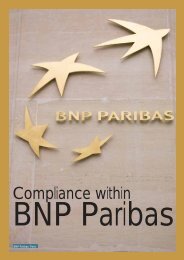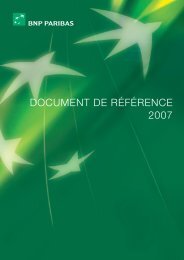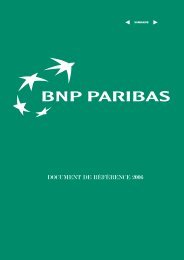2007 REGISTRATION DOCUMENT
2007 REGISTRATION DOCUMENT
2007 REGISTRATION DOCUMENT
- No tags were found...
Create successful ePaper yourself
Turn your PDF publications into a flip-book with our unique Google optimized e-Paper software.
CONSOLIDATED FINANCIAL STATEMENTS5Notes to the financial s tatements p repared in accordance with I nternational Financial Reporting S tandards as adopted by the European Union< Contents >A similar accounting treatment is applied to deferred share-basedcompensation plans.1.i.2Share subscriptions or purchasesoffered to employees under thecompany savings planShare subscriptions or purchases offered to employees under the companysavings plan (Plan d’Épargne Entreprise) at lower-than-market rates overa specified period do not include a vesting period. However, employeesare prohibited by law from selling shares acquired under this plan for aperiod of five years. This restriction is taken into account in measuringthe benefit to the employees, which is reduced accordingly. The benefittherefore equals the difference, at the date the plan is announced toemployees, between the fair value of the share (after allowing for therestriction on sale) and the acquisition price paid by the employee,multiplied by the number of shares acquired.The cost of the mandatory five-year holding period is equivalent to thecost of a strategy involving the forward sale of shares subscribed at thetime of the capital increase reserved for employees and the cash purchaseof an equivalent number of BNP Paribas shares on the market, financedby a loan repaid at the end of a five-year period out of the proceeds fromthe forward sale transaction. The interest rate on the loan is the ratethat would be applied to a five-year general purpose loan taken out byan individual with an average risk profile. The forward sale price for theshares is determined on the basis of market parameters.1.j PROVISIONS RECORDED UNDERLIABILITIESProvisions recorded under liabilities (other than those relating to financialinstruments, employee benefits and insurance contracts) mainly relate torestructuring, claims and litigation, fines and penalties, and tax risks.A provision is recognised when it is probable that an outflow of resourcesembodying economic benefits will be required to settle an obligationarising from a past event, and a reliable estimate can be made of theamount of the obligation. The amount of such obligations is discounted,where the impact of discounting is material, in order to determine theamount of the provision.1.k CURRENT AND DEFERRED TAXESThe current income tax charge is determined on the basis of the taxlaws and tax rates in force in each country in which the Group operatesduring the period in which the income is generated.Deferred taxes are recognised when temporary differences arise betweenthe carrying amount of an asset or liability in the balance sheet and itstax base.Deferred tax liabilities are recognised for all taxable temporary differencesother than:■ taxable temporary differences on initial recognition of goodwill;■ taxable temporary differences on investments in enterprises underthe exclusive or joint control of the Group, where the Group is ableto control the timing of the reversal of the temporary difference andit is probable that the temporary difference will not reverse in theforeseeable future.Deferred tax assets are recognised for all deductible temporarydifferences and unused carryforwards of tax losses only to the extentthat it is probable that the entity in question will generate future taxableprofits against which these temporary differences and tax losses canbe offset.Deferred tax assets and liabilities are measured using the liability method,using the tax rate which is expected to apply to the period when theasset is realised or the liability is settled, based on tax rates and tax lawsthat have been or will have been enacted by the balance sheet date ofthat period. They are not discounted.Deferred tax assets and liabilities are offset when they arise within agroup tax election under the jurisdiction of a single tax authority, andthere is a legal right of offset.Current and deferred taxes are recognised as tax income or expense inthe profit and loss account, except deferred taxes relating to unrealisedgains or losses on available-for-sale assets or to changes in the fairvalue of instruments designated as cash flow hedges, which are takento shareholders’ equity.When tax credits on revenues from receivables and securities are usedto settle corporate income tax payable for the period, the tax creditsare recognised on the same line as the income to which they relate. Thecorresponding tax expense continues to be carried in the profit and lossaccount under “Corporate income tax”.1.l STATEMENT OF CASH FLOWSThe cash and cash equivalents balance is composed of the net balanceof cash accounts and accounts with central banks and post office banks,and the net balance of interbank demand loans and deposits.Changes in cash and cash equivalents related to operating activitiesreflect cash flows generated by the Group’s operations, including cashflows related to investment property, held-to-maturity financial assetsand negotiable certificates of deposit.Changes in cash and cash equivalents related to investing activitiesreflect cash flows resulting from acquisitions and disposals of subsidiaries,associates or joint ventures included in the consolidated group, as wellas acquisitions and disposals of property, plant and equipment excludinginvestment property and property held under operating leases.Changes in cash and cash equivalents related to financing activitiesreflect the cash inflows and outflows resulting from transactions withshareholders, cash flows related to bonds and subordinated debt, anddebt securities (excluding negotiable certificates of deposit).1234567891011<strong>2007</strong> Registration document - BNP PARIBAS 127
















